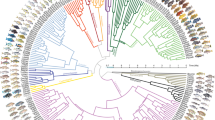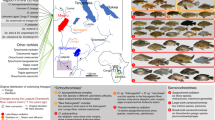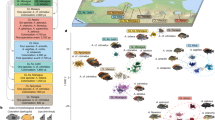Abstract
Speciation rates vary considerably among lineages, and our understanding of what drives the rapid succession of speciation events within young adaptive radiations remains incomplete1,2,3,4,5,6,7,8,9,10,11. The cichlid fish family provides a notable example of such variation, with many slowly speciating lineages as well as several exceptionally large and rapid radiations12. Here, by reconstructing a large phylogeny of all currently described cichlid species, we show that explosive speciation is solely concentrated in species flocks of several large young lakes. Increases in the speciation rate are associated with the absence of top predators; however, this does not sufficiently explain explosive speciation. Across lake radiations, we observe a positive relationship between the speciation rate and enrichment of large insertion or deletion polymorphisms. Assembly of 100 cichlid genomes within the most rapidly speciating cichlid radiation, which is found in Lake Victoria, reveals exceptional ‘genomic potential’—hundreds of ancient haplotypes bear insertion or deletion polymorphisms, many of which are associated with specific ecologies and shared with ecologically similar species from other older radiations elsewhere in Africa. Network analysis reveals fundamentally non-treelike evolution through recombining old haplotypes, and the origins of ecological guilds are concentrated early in the radiation. Our results suggest that the combination of ecological opportunity, sexual selection and exceptional genomic potential is the key to understanding explosive adaptive radiation.
This is a preview of subscription content, access via your institution
Access options
Access Nature and 54 other Nature Portfolio journals
Get Nature+, our best-value online-access subscription
$29.99 / 30 days
cancel any time
Subscribe to this journal
Receive 51 print issues and online access
$199.00 per year
only $3.90 per issue
Buy this article
- Purchase on Springer Link
- Instant access to full article PDF
Prices may be subject to local taxes which are calculated during checkout



Similar content being viewed by others
Data availability
Genomic data are available at NCBI BioProject (PRJNA626405) other data are available from Dryad (https://doi.org/10.5061/dryad.fn2z34tr0), including trees and networks labelled by species.
Code availability
Scripts are available from Dryad (https://doi.org/10.5061/dryad.fn2z34tr0).
References
Otte, D. & Endler, J. Speciation and its Consequences (Sinauer, 1989).
Coyne, J. A. & Orr, H. A. Speciation (Sinauer, 2004).
Gavrilets, S. Fitness Landscapes and the Origin of Species (MPB-41) Vol. 41 (Princeton Univ. Press, 2004).
Dieckmann, U., Doebeli, M., Metz, J. A. & Tautz, D. (eds) Adaptive Speciation (Cambridge Univ. Press, 2004).
Mayr, E. & Diamond, J. M. The Birds of Northern Melanesia: Speciation, Ecology & Biogeography (Oxford Univ. Press, 2001).
Nosil, P. Ecological Speciation (Oxford Univ. Press, 2012).
Seehausen, O. et al. Genomics and the origin of species. Nat. Rev. Genet. 15, 176–192 (2014).
Wolf, J. B. & Ellegren, H. Making sense of genomic islands of differentiation in light of speciation. Nat. Rev. Genet. 18, 87–100 (2017).
Flaxman, S. M., Wacholder, A. C., Feder, J. L. & Nosil, P. Theoretical models of the influence of genomic architecture on the dynamics of speciation. Mol. Ecol. 23, 4074–4088 (2014).
Schluter, D. The Ecology of Adaptive Radiation (Oxford Univ. Press, 2000).
Marques, D. A., Meier, J. I. & Seehausen, O. A combinatorial view on speciation and adaptive radiation. Trends Ecol. Evol. 34, 531–544 (2019).
Witte, F. & Van Oijen, M. J. P. Taxonomy, Ecology and Fishery of Lake Victoria Haplochromine Trophic Groups (Nationaal Natuurhistorisch Museum, 1990).
Jetz, W., Thomas, G. H., Joy, J. B., Hartmann, K. & Mooers, A. O. The global diversity of birds in space and time. Nature 491, 444–448 (2012).
Harvey, M. G. & Rabosky, D. L. Continuous traits and speciation rates: alternatives to state-dependent diversification models. Methods Ecol. Evol. 9, 984–993 (2018).
Rabosky, D. L. et al. An inverse latitudinal gradient in speciation rate for marine fishes. Nature 559, 392–395 (2018).
Carpenter, B. et al. Stan: a probabilistic programming language. J. Stat. Softw. 76, 1–32 (2017).
Rabosky, D. L. & Goldberg, E. E. FiSSE: a simple nonparametric test for the effects of a binary character on lineage diversification rates. Evolution 71, 1432–1442 (2017).
Jackson, P. B. N. The impact of predation, especially by the tiger-fish (Hydrocyon vittatus Cast.) on African freshwater fishes. Proc. Zool. Soc. Lond. 136, 603–622 (1961).
Wagner, C. E., Harmon, L. J. & Seehausen, O. Ecological opportunity and sexual selection together predict adaptive radiation. Nature 487, 366–369 (2012).
Beaulieu, J. M. & O’Meara, B. C. Detecting hidden diversification shifts in models of trait-dependent speciation and extinction. Syst. Biol. 65, 583–601 (2016).
Turner, I., Garimella, K. V., Iqbal, Z. & McVean, G. Integrating long-range connectivity information into de Bruijn graphs. Bioinformatics 34, 2556–2565 (2018).
Meier, J. I., et al. The coincidence of ecological opportunity with hybridization explains rapid adaptive radiation in Lake Mweru cichlid fishes. Nat. Commun. 10, 5391 (2019).
Trewavas, E. A Revision of the Genus Serranochromis Regan (Pisces, Cichlidae) (Musée royal de l’Afrique Centrale, 1964).
Meier, J. I. et al. Ancient hybridization fuels rapid cichlid fish adaptive radiations. Nat. Commun. 8, 14363 (2017).
Palamara, P. F., Lencz, T., Darvasi, A. & Pe’er, I. Length distributions of identity by descent reveal fine-scale demographic history. Am. J. Hum. Genet. 91, 809–822 (2012).
Browning, S. R. & Browning, B. L. Rapid and accurate haplotype phasing and missing-data inference for whole-genome association studies by use of localized haplotype clustering. Am. J. Hum. Genet. 81, 1084–1097 (2007).
Ralph, P. & Coop, G. The geography of recent genetic ancestry across Europe. PLoS Biol. 11, e1001555 (2013).
Meier, J. I. et al. Demographic modelling with whole-genome data reveals parallel origin of similar Pundamilia cichlid species after hybridization. Mol. Ecol. 26, 123–141 (2017).
Streelman, J. T. & Danley, P. D. The stages of vertebrate evolutionary radiation. Trends Ecol. Evol. 18, 126–131 (2003).
Gillespie, R. G. et al. Comparing adaptive radiations across space, time, and taxa. J. Hered. 111, 1–20 (2020).
Acknowledgements
We thank R. Bireley and the Sacramento Aquarium Society, P. George and the New England Cichlid Association, M. Welss and the IgV, R. Borstein of the Greater Chicago Cichlid Association and the American Cichlid Association for advice and access to specimens for photography in Fig. 1, K. Pedersen and J. Øgaard for Uganda fieldwork assistance along with NaFiRRI staff, including J. Balirwa, as well as cooperation from Kyoga region village elders, TAFIRI for hosting O.S. and team members during fieldwork, M. Kayeba, M. Haluna and H. Mrosso for assistance with Tanzanian fieldwork and K. Wagner, J. van Rijssel, F. Moser, O. Selz and L. Kaufman for discussions. This research was funded by Swiss National Science Foundation grant 31003A_163338 to O.S., L.E. and R.B., an American Cichlid Association Guy Jordan Fellowship to S.R.B. and Australian Research Council DE180101558 to M.D.M.
Author information
Authors and Affiliations
Contributions
M.D.M. and S.R.B. designed the phylogenetic analyses with assistance from O.S. and B.O’M. Trait data were gathered by S.R.B. and O.S. with assistance from M.D.M. GIS data were gathered by M.D.M. Genomic data was gathered by S.M., J.I.M. and M.D.M. M.D.M. and O.S. designed the genomic analyses with assistance from J.I.M. and advice from D.A.M., L.E. and R.B. M.D.M. performed fieldwork in Uganda with assistance from A.T. and coordination by O.S. O.S. and S.M. performed fieldwork in Tanzania with assistance from M.A.K. M.D.M. and O.S. wrote the manuscript with assistance from S.R.B., D.A.M. and J.I.M., with comments from and final version approval by all authors.
Corresponding authors
Ethics declarations
Competing interests
The authors declare no competing interests.
Additional information
Peer review information Peer reviewer reports are available.
Publisher’s note Springer Nature remains neutral with regard to jurisdictional claims in published maps and institutional affiliations.
Extended data figures and tables
Extended Data Fig. 1 D-statistics across the Victoria radiation.
a, Multispecies coalescent tree generated by ASTRAL for Lake Victoria cichlids (n = 100 species). Species diets and habitats are coded by colour and shape, respectively. b, The same arrangement of taxa as the coalescent tree, but highlighting the highest D-statistic associated with each genome. c, The 95% credible intervals of the ecology and sexual selection-based predictors of high introgression (Bonferroni-corrected P < 0.05 jackknife of the D-statistic) are shown, taking into account the non-independence of comparisons between the same genomes. Effect sizes (odds ratio = eeffect size) indicate whether introgression is more likely when the ingroup genomes (A + B) have a similar diet, habitat or male nuptial coloration, or whether introgression is more likely when the potentially introgressing genomes (B + C) do. Photographs were produced by the authors (O.S. and M.D.M.).
Supplementary information
Supplementary Information
This file contains Supplementary Methods and additional discussion, including additional information on phylogeny construction, comparative models, STAN output, genotyping, indels, and IBD models. It includes 10 Supplementary Tables and 3 Supplementary Figs.
Rights and permissions
About this article
Cite this article
McGee, M.D., Borstein, S.R., Meier, J.I. et al. The ecological and genomic basis of explosive adaptive radiation. Nature 586, 75–79 (2020). https://doi.org/10.1038/s41586-020-2652-7
Received:
Accepted:
Published:
Issue Date:
DOI: https://doi.org/10.1038/s41586-020-2652-7
This article is cited by
-
East African cichlid fishes
EvoDevo (2023)
-
A continuous fish fossil record reveals key insights into adaptive radiation
Nature (2023)
-
Just below the surface, the pelagic haplochromine cichlids from the Lake Edward system
Hydrobiologia (2023)
-
Exceptional Genetic Differentiation at a Micro-geographic Scale in Apistogramma agassizii (Steindachner, 1875) from the Peruvian Amazon: Sympatric Speciation?
Evolutionary Biology (2023)
-
Draft genome of six Cuban Anolis lizards and insights into genetic changes during their diversification
BMC Ecology and Evolution (2022)
Comments
By submitting a comment you agree to abide by our Terms and Community Guidelines. If you find something abusive or that does not comply with our terms or guidelines please flag it as inappropriate.



